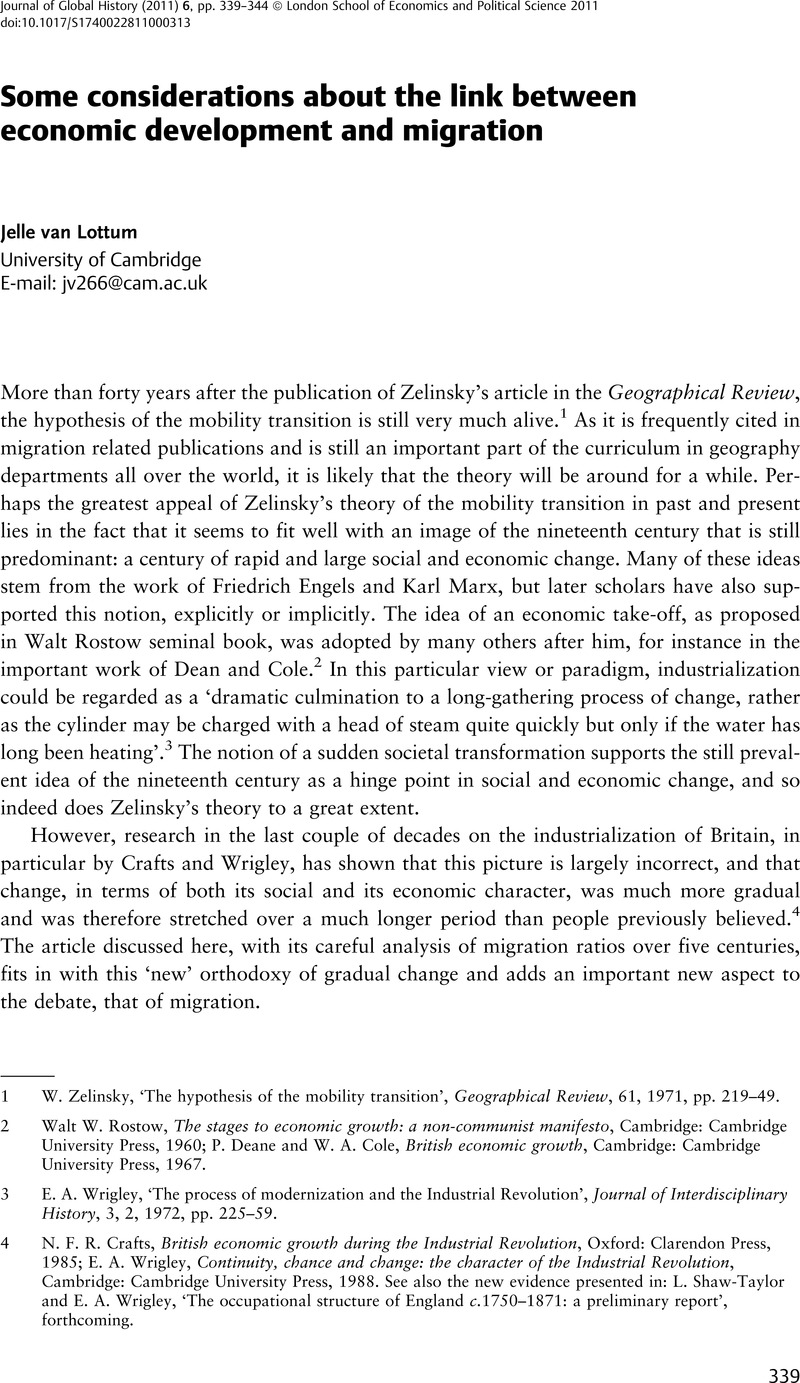Article contents
Some considerations about the link between economic development and migration
Published online by Cambridge University Press: 13 June 2011
Abstract

- Type
- Articles
- Information
- Copyright
- Copyright © Cambridge University Press 2011
References
1 W. Zelinsky, ‘The hypothesis of the mobility transition’, Geographical Review, 61, 1971, pp. 219–49.
2 Rostow, Walt W., The stages to economic growth: a non-communist manifesto, Cambridge: Cambridge University Press, 1960Google Scholar; Deane, P. and Cole, W. A., British economic growth, Cambridge: Cambridge University Press, 1967Google Scholar.
3 E. A. Wrigley, ‘The process of modernization and the Industrial Revolution’, Journal of Interdisciplinary History, 3, 2, 1972, pp. 225–59.
4 Crafts, N. F. R., British economic growth during the Industrial Revolution, Oxford: Clarendon Press, 1985Google Scholar; Wrigley, E. A., Continuity, chance and change: the character of the Industrial Revolution, Cambridge: Cambridge University Press, 1988CrossRefGoogle Scholar. See also the new evidence presented in: L. Shaw-Taylor and E. A. Wrigley, ‘The occupational structure of England c.1750–1871: a preliminary report’, forthcoming.
5 See, for instance, the approach adopted in Hatton, Timothy J. and Williamson, Jeffrey G., The age of mass migration: causes and economic impact, Oxford, Oxford University Press, 1998Google Scholar.
6 See J. L. van Zanden, ‘The “revolt of the early modernist” and the “first modern economy”: an assessment’, Economic History Review, 55, 4, 2002, pp. 619–41; Robert. C. Allen, ‘The great divergence in European wages and prices from the middle ages to the First World War’, Explorations in Economic History, 38, 2001, pp. 411–47. For a broader perspective on comparative Anglo-Dutch history, see Davids, Karel and Lucassen, Jan, A miracle mirrored: the Dutch Republic in European perspective, Cambridge: Cambridge University Press, 1995Google Scholar.
7 Van Zanden, ‘Revolt of the early modernist’; Allen, ‘Great divergence’.
8 Wrigley, ‘Modernization’, pp. 227, 229–30.
9 Ibid., p. 237.
10 Vries, Jan de and Woude, Ad van der, The first modern economy: success, failure, and perseverance of the Dutch economy, 1500–1815, Cambridge: Cambridge University Press, 1997CrossRefGoogle Scholar.
11 Wrigley, ‘Modernization’, pp. 258–9.
12 Jelle van Lottum and Peter Kitson, ‘Migration, economic development and human capital in early Victorian England’, unpublished paper for the Economic History Society conference, Durham, 2010.
13 Shaw-Taylor and Wrigley, ‘Occupational structure’.
14 Tine de Moor and Jan Luiten van Zanden, ‘“Every woman counts”: a gender-analysis of numeracy in the Low Countries during the early modern period’, Journal of Interdisciplinary History, 41, 2, 2010, pp. 179–208; Jan Luiten van Zanden, The long road to the Industrial Revolution: the European economy in a global perspective, 1000–1800, Leiden and Boston: Brill, 2009, ch. 5; Jelle van Lottum and Bo Poulsen, ‘Estimating levels of numeracy and literacy in the maritime sector of the north Atlantic in the late eighteenth century’, Scandinavian Economic History Review, 59, 1, 2011, pp. 67–82; J. van Lottum and J. L. van Zanden, ‘Labour productivity and human capital in the maritime sector of the north Atlantic, c. 1672–1815’, unpublished paper for the Economic and Social History Seminar, Utrecht, 2011.
15 Jan Lucassen, ‘Labour and early modern economic development’, in Davids and Lucassen, Miracle mirrored, pp. 367–409; Lottum, Jelle van, Across the North Sea: the impact of the Dutch Republic on international labour migration, c. 1550–1850, Amsterdam: Aksant, 2007Google Scholar.
16 Jelle van Lottum, ‘Labour migration and economic performance: London and the Randstad, c. 1600–1800’, Economic History Review, forthcoming, published online August 2010, http://onlinelibrary.wiley.com/doi/10.1111/j.1468-0289.2010.00547.x/pdf (consulted 9 April 2011).
17 J. van Lottum, ‘Migration to the Netherlands in the first half of the nineteenth century: an assessment using the Utrecht censuses of 1829 and 1839’, Annales de Démographie Historique, 118, 2009, pp. 193–208.
18 Van Lottum, ‘Labour migration’; van Lottum and van Zanden, ‘Labour productivity’.
19 Robert E. Lucas Jr, ‘On the mechanics of economic development’, Journal of Monetary Economics, 22, 1988, pp. 3–42; idem, Lectures on economic growth, Cambridge: Cambridge University Press, 2002.
20 Lucas, Robert E. B., International migration and economic development: lessons from low-income countries, Cheltenham: Edward Elgar, 2005.Google Scholar
21 Crafts, British economic growth, p. 82.
22 Mokyr, Joel, The gifts of Athena, Princeton, NJ: Princeton University Press, 2002Google Scholar; idem, The enlightened economy: an economic history of Britain, 1700–1850, Princeton, NJ: Princeton University Press, 2010.
23 See van Zanden, Industrial Revolution, ch. 5.
24 Van Lottum, ‘Labour migration’.
25 Manning, Patrick, Migration in world history, London: Routledge, 2005, p. 7Google Scholar.
26 Wrigley, ‘Modernization and industrialization’, p. 227.
- 1
- Cited by


